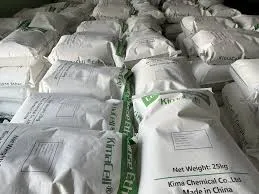
Nov . 01, 2024 01:01 Back to list
Understanding HPMC Its Uses and Significance in Various Industries
Understanding HPMC What Is It?
Hydroxypropyl methylcellulose (HPMC) is a cellulose derivative that has gained significant attention across various industries due to its versatile properties. It is a white, odorless, and tasteless powder primarily used as a thickening agent, film-forming agent, and emulsifier. With applications ranging from pharmaceuticals and food products to personal care and construction, HPMC plays a crucial role in many formulations.
Chemical Properties and Structure
HPMC is synthesized from cellulose, a natural polymer derived from plant cell walls. The cellulose undergoes etherification, where hydroxyl groups on the cellulose chains are replaced with hydroxypropyl and methyl groups. This modification allows HPMC to become soluble in water, unlike native cellulose. The degree of substitution, which refers to the number of hydroxyl groups that have been modified, influences the properties of HPMC, including its solubility, viscosity, and gel-forming capacity.
Applications Across Industries
1. Pharmaceuticals In the pharmaceutical industry, HPMC is commonly used as a binder, thickener, and controlled-release agent in various formulations. It helps in the uniform distribution of active ingredients in tablets and capsules, enhancing the bioavailability of the drugs. Additionally, HPMC is utilized in ophthalmic solutions for its ability to provide lubrication and moisture retention.
2. Food Industry HPMC is recognized as a food additive (E464) due to its stabilizing and thickening properties. It is frequently used in gluten-free baked goods to enhance texture and moisture retention. HPMC also acts as an emulsifier in sauces and dressings, helping to create a more desirable mouthfeel and preventing separation.
hpmc que es

3. Personal Care Products In cosmetics and personal care products, HPMC is employed as a thickener and film-forming agent, providing a smooth texture and improving product stability. It is commonly found in lotions, shampoos, and gel formulations.
4. Construction and Building Materials HPMC is increasingly used in construction materials such as tile adhesives, joint compounds, and texture coatings. Its water-retention properties and ability to improve bonding performance make it an essential component in modern construction applications.
Benefits of Using HPMC
One of the significant advantages of HPMC is its non-toxic nature, making it suitable for applications in the food and pharmaceutical industries. It is also versatile, with a wide range of grades available to meet specific requirements for viscosity, solubility, and thermal stability. Furthermore, HPMC is environmentally friendly, being derived from natural cellulose and biodegradable.
Conclusion
In conclusion, Hydroxypropyl methylcellulose (HPMC) is a remarkable multifunctional polymer with diverse applications spanning several industries. Its ability to act as a thickener, emulsifier, and stabilizer makes it invaluable in formulating various products, from medications to building materials. Understanding the properties and uses of HPMC is crucial for professionals in relevant fields, as it continues to play an essential role in innovation and product development. As we advance, the applications and benefits of HPMC are likely to expand, reinforcing its status as a vital ingredient in modern formulations.
-
Versatile Hpmc Uses in Different Industries
NewsJun.19,2025
-
Redispersible Powder's Role in Enhancing Durability of Construction Products
NewsJun.19,2025
-
Hydroxyethyl Cellulose Applications Driving Green Industrial Processes
NewsJun.19,2025
-
Exploring Different Redispersible Polymer Powder
NewsJun.19,2025
-
Choosing the Right Mortar Bonding Agent
NewsJun.19,2025
-
Applications and Significance of China Hpmc in Modern Industries
NewsJun.19,2025







